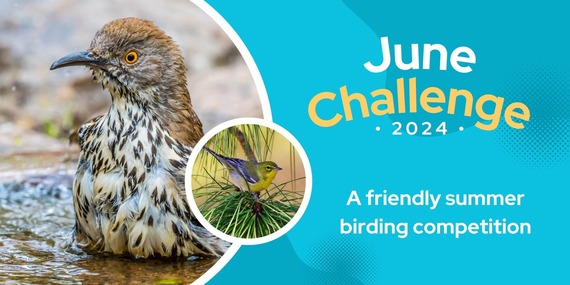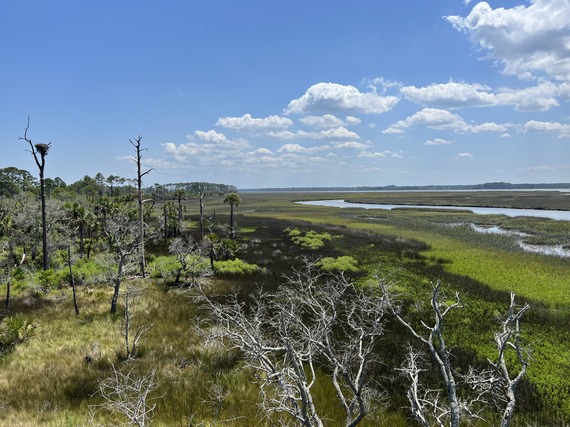 The June Challenge is a friendly competition for birders to keep having fun despite the summer heat. This special Florida event started in Alachua County in 2004 and has since spread statewide. The goal is for participants to observe as many bird species as possible within their county from June 1 to June 30.
Here are the rules:
1. Only count birds found within a single county. Doing the challenge in your home county lets you explore local birding spots with a new eye, and maybe find something you’d previously missed. While you can participate in multiple counties, each county must be reported separately.
2. Each bird on your list must be seen, not just heard. Though some have objected to this rule, it’s important not to harass secretive birds to get them to appear. Respect the birds, use tapes sparingly, and rely on patience and birding skill. Reviewing the American Birding Association’s Code of Ethics is recommended.
3. This is a friendly competition. Compete to get the longest bird list for your county, but please share your discoveries with others. This makes for a spirited contest and gives others the chance to enjoy particularly exciting discoveries.
4. Any free-flying bird can be included on your Challenge list, once it is not captive, released or escaped. Your count will be displayed as two numbers: the total ABA-countable species seen, followed by the number of non-countable species. Rankings are based on the ABA-countable species, with non-ABA species serving as tiebreakers, so make sure to keep track!
Submit your list during the first week of July to enter the competition! The submission link can be found on the June Challenge page, but it won’t be live until July 1, so keep it bookmarked.
Looking for a checklist? Download the Official Florida State Bird List from the Florida Ornithological Society or get FWC’s free PDF or hard copy booklet here.
 Display at the Guana Tolomato Matanzas National Estuarine Research Reserve Visitor Center. Photo by Lauren Ali.
The affectionately abbreviated GTM NERR is a must-see for nature lovers. Less than half an hour from the charm of downtown St. Augustine, it spans over 76,000 acres of protected lands from Ponte Vedra Beach to Palm Coast in northeast Florida and has more than 200 bird species reported on eBird. Start your journey with a warm welcome at the Visitor Center, which features exciting exhibits, aquariums, classrooms, laboratories, an auditorium and an outdoor amphitheater with views of the Guana River. On a recent visit, Birding Trail staff observed flocks of glossy ibis overhead and a green sea turtle chomping on aquatic vegetation right outside the Center, as well as a variety of terns, brown pelicans and other shorebirds.
Beyond the Visitor Center is an extensive trail network covering not only the GTM NERR but adjacent public lands, including Guana River Wildlife Management Area. Use them to explore a variety of habitats, including estuaries, mangroves, salt marshes, maritime hammocks and pine flatwoods. This diversity of ecosystems supports an impressive array of bird species throughout the year. The complex of conservation lands in the Guana River area is a critical stopover for many migratory birds, including White Pelicans in the winter and raptors like Peregrine Falcons. The adjacent Guana River WMA has a viewing tower that puts birders level with an osprey nest, offering unusually close up views of this common but beloved bird. Warblers and vireos also pass through in large numbers. Shorebirds such as the Black-bellied Plover and Ruddy Turnstone can be seen along the beaches and mudflats.
 View from the tower at Guana River Wildlife Management Area, which connects to Guana Tolomato Matanzas National Estuarine Research Reserve. Photo by Lauren Ali.
Wildlife watching in the Guana River area is not limited to birds. Diverse ecosystems support a wide range of mammals, reptiles and amphibians. White-tailed deer are frequently seen in the upland areas, and bobcats, though more elusive, are also present. The Reserve's waterways are home to American alligators, which can often be seen basking along the banks. River otters, raccoons and marsh rabbits may also be encountered. One of the unique aspects of wildlife watching at GTM NERR is the opportunity to see marine mammals. Dolphins and right whales have been spotted in the adjacent Atlantic Ocean and manatees can sometimes been seen in the estuarine waters, especially during the warmer months.
|